IJCRR - 13(21), November, 2021
Pages: 19-26
Date of Publication: 09-Nov-2021
Print Article
Download XML Download PDF
Morphologic and Morphometric Analysis of External Ear: A Preliminary Study on Monozygotic Twins for Personal Identification
Author: Baroniya Yash, Das Tanurup, Harshey Abhimanyu, Srivastava Ankit
Category: Healthcare
Abstract:Introduction: Monozygotic twins have remained a mystery for researchers since their discovery in the early twentieth cen�tury. As a result of the same set of genetic materials, monozygotic twins share almost similar morphological features. Hence, distinguishing monozygotic twins based on their physical appearance remains a formidable challenge for criminal investiga�tors. The ear is one of the unique features of the human body. Aims: Previous researchers explored numerous features of the external ear for personal identification in different populations but no studies are available on the comparative analysis of identical twin's external ear. The present study investigates the mor�phologic and morphometric features of monozygotic twins. Methodology: Samples under the study were collected randomly from 37 pairs of monozygotic twins from central India. Differ�ent morphological features were recorded by keeping the previous literature as references. Vernier calliper is used to measure the length and breadth of the ear. Result: Oval shape and round-shaped ears are most and least frequent, respectively. Arch and triangular-shaped ear lobules have the highest and lowest frequency, respectively. The length and breadth of the right and left ears of the twin pairs have de�picted a very high correlation. Observed results of the present study revealed precisely that selected features of the external ear of the corresponding sides in both individuals of each twin pair have no significant difference. Conclusion: This study concluded that the ears of monozygotic twins are morphologically identical. Although they have some minor morphometric variations, they can potentially distinguish them from each other.
Keywords: External ear, Monozygotic twins, Morphological features, Morphometric variation, Criminal investigation Personal identification
Full Text:
Introduction
Twins and issues inextricably related to them are consistently capturing severe attention towards the scientific research community from the last century. In the late 19th century J Matthews, a Scottish obstetrician first recognized two specific types of twins. But, Francis Galton was the first person to coin the distinct possibility of applying twins for the comparison of hereditary and environmental contributions.1,2 Twins are typically classified into two specific categories i.e., monozygotic (Identical: naturally divided from a single fertilized egg) and dizygotic (Fraternal: formed by two independently fertilized eggs by two different sperms).2,3 Monozygotic twins are virtually identical because they universally share the same chromosomal sequence4 except for very few rare mutations.5 Individualization of monozygotic twins without modern genetic sequencing techniques in common remain a critical task as they naturally possess almost identical phenotypic appearance.6,7 They easily hide or swap their distinctive identity by exploiting the key advantage of striking similarity to voluntarily commit crimes. The distinct population of monozygotic twins is gradually increasing around the globe and including India in the last few decades. In 2013, a high frequency of twins was observed during a health camp in Kodinhi, a village in Kerala, by the members of Yenepoya Dental College, Mangalore, Karnataka. A further survey revealed that there was a ratio of 35 twins out of every 1,000 individuals.3 Personal identification plays a vital role in the field of forensic sciences. The modern Biometric system is most reliable to positively establish the personal identity based on the morphological and behavioural characteristics of an individual.8,9 Ear biometrics is undoubtedly an emerging technique in the field of personal identification. The science of human identification from ear impressions or prints is called Forensic Otoscopy.10 It possesses several overwhelming advantages as a biometric feature due to its stability (mostly invariable during various facial expressions and poses) and peculiar structure. The remarkable peculiarity of the external ear comprises several anatomical features i.e., auricle shape, earlobe shape (Lobule), attachment of the earlobe (Lobule), helix shape and tragus shape.10,11 Figure 1 demonstrates the various morphological characteristics of the ear. The oily and waxy surface of the external ear (Pinna or auricle) is responsible for the Ear prints on a contrasting surface.10,11 Ear prints are found in cases where a criminal try to overhear the private conversation behind the other side of the door or window.10 The first direct involvement of the ear in a forensic issue dated in 1910. In that case, the distinctive identity of a prisoner was scientifically proved with the help of the remarkable peculiarity of his ear.11 It can also be a vital feature for personal identification in the case of the mutilated body or in a circumstance where the alleged suspect has gone through plastic surgery. In recent years, crimes often been recorded in overhead CCTV cameras. A considerable chance of excellent visibility of a person’s pinna in raw CCTV footage can be properly investigated and identified with a forensic expert.10 In previous studies on ear patterns or prints, researchers proved its uniqueness in every person and no two individuals can have the same set of morphological characteristics on the external ear.10-19 Preliminary research was also conducted on the variations of external ear prints of monozygotic twins.20 But, no studies are present on the morphologic and morphometric similarities and dissimilarities of identical twins’ external ears. A present study is a preliminary approach aimed at the comprehensive examination of the morphological features and differences of external ears among monozygotic twins.
Methodology
The present study has been conducted to carefully analyse the morphology and morphometry of the external ear of monozygotic twins. A total of 37 pairs (74 subjects) of monozygotic twins aged between 5 to 40 years was examined in this study. All the samples were randomly collected from three different regions of central India i.e., Jhansi, Bhopal, and Shivpuri. A valid written informed consent was obtained from the parents of the subjects under the age of 18 years as well as from the adult subjects before the study. All the subjects were properly informed about the specific purpose and fundamental nature of the experiment.
Image acquisition
Female subjects were asked to remove jewellery from their ear and tie up their hairs before the image acquisition. All the images were captured through ‘NIKON COOLPIX L 21’ in a stationary position from 1 meter with the head in Frankfurt Horizontal Plane (A parallel line joining the orbitale and tragion). The maximum vertical length and maximum horizontal width (figure 2a) were recorded by Vernier Calliper (figure 2b). Figure 3a and 3b show the right ears of two individuals of a twin pair.
Data interpretation and statistical analysis
Five features i.e., ear length, ear width, lobular attachment, the shape of auricle and shape of lobule were observed and recorded. Images were categorized based on the shape of the auricle, lobule of ear and attachment of lobule. Based on auricle, shape ear is classified into four categories described in table 1. Four types of lobules are present in the human ear i.e., Arched, Round, Triangular and Rectangular. The correlation coefficient (R) was calculated between the following quantitative features:
1. Between the lengths of the right ears of the two individuals of twin pairs.
2. Between the breadths of the right ears of the two individuals of twin pairs.
3. Between the lengths of the left ears of the two individuals of twin pairs.
4. Between the breadths of left ears of the two individuals of twin pairs.
5. Between the lengths of the right and left ears of the same individual.
6. Between the breadth of right and left ears of the same individual.
The length and breadth of each ear were plotted in an X-Y plane to find out the corresponding two-dimensional vector. The two-dimensional vector of the same ear (right vs right and left vs left) from the two individuals of a twin pair was compared by finding the Euclidean distance between them.
Results
The present study was carefully conducted to study the morphological and morphometric features of the external ear of monozygotic twins. The study shows that all the selected morphological features were the same in a twin pair. Figures 4.a and 4.b show the right ear of two individuals of a twin pair. Although the length and breadth of each ear slightly differ between the individuals of a twin pair.
The distribution of auricle shape among all the twin pairs shows that the oval-shaped ear is the most frequent with 43.24% and the round-shaped ear is the least frequent with 10.81%. Table 2 and figure 4. demonstrate the frequency distribution of all the auricle shapes. Figure 5. a to 5.d shows the different auricle shapes found on the present samples of monozygotic twins. Arch-shaped ear lobule has the highest frequency of 45.94% among all the twin pairs and a triangular lobule has the lowest frequency of 8.10%. Table 3 and figure 4. b demonstrate the frequency of all the ear lobule shapes. The attached ear lobule is more frequent than the free lobule among the twin pairs. Table 4 and figure 4. c demonstrate the distribution of the attached and free lobule percentage among the twins.
The calculated ‘R’ values between the length of right ears of twin pairs and breadth of right ears of twin pairs were 0.99 and 0.95 respectively. The calculated ‘R’ values between the length of left ears of twin pairs and breadth of left ears of twin pairs were 0.98 and 0.95 respectively. The calculated ‘R-value between the length of the right and left ears of an individual was 0.99. The calculated ‘R-value between the breadth of the right and left ears of an individual was 0.97. A positive Euclidean distance was found between the same ears of every twin pair under the study. Table 5 shows all the Euclidean distances between the vector values of right and left ears in all the twin pairs. Figures 6.a and 6b show the euclidean distances between the right ears and left ears of twin pair 2 respectively. The lowest and highest Euclidean distances between the vector values of the left ear among all the twin pairs are 0.1 and 0.36056 respectively. The average Euclidean distances between the vector values of the right ears and vector values of left ears among all the twin pairs are 0.19674 and 0.22868 respectively.
Discussion
The obtained results of the present study show that morphological characteristics of the external ear are identical between the individuals of a twin pair. The appropriate size of each ear is marginally different to every individual of a twin pair which is proof of the uniqueness. Several previous studies indicated the differences between structure and morphological characters of the ear between individuals for forensic purposes.21-24
The present study shows that 43.24% of twin pairs have an oval-shaped auricle. The oval shape is found to be the most frequent among all. Similar results were properly obtained in the comprehensive studies by Krishan et al. (36%— 40% in males and 39— 46% in females) 10, Iannarelli (40-46%) 25 and Singh and Purkait (47-52%).24 Van der Lugt 26 found 68.75 and 65% oval shape in Dutch males and American males. Yadav et al. 27 equally determined a similar frequency of oval shapes (61.33%) in a North Indian population. Round-shaped ears found in 10.81% of twin pairs in the present study. Krishan et al. 10 found 18 - 20% and 15 – 18.4% round-shaped ears in males and females of Himachal Pradesh, India respectively. Singh and Purkait 24 found a 23-59% round ear in the central Indian population, and Van der Lugt 26 found a round-shaped ear in 3% Dutch males and 2% American males. Yadav et al. 27 observed 14.66% round ear in a North Indian population. The rectangular auricle is present in 24.32% of twins in the present study. Krishan et al. 10 observed a dissimilar frequency of rectangular auricle (2– 8.9% in males and 7– 9.2% in females) in his similar study to the study on Dutch males 26 (9.1%). On the contrary, only 3% of Americans invariably showed rectangular auricle shape 26. Yadav et al. 27 observed a 12.66% rectangular ear in his study. 21.62% among all the twin pairs have a triangular auricle. Krishan et al. 10 found less percentage of the triangular auricle in their study (6 – 8.9% in males and 10 – 12.9% in females). Only 8.33% of triangular ears were observed in the study of Yadav et al 27.
Arch shaped lobule is the most frequent with 45.94% and a triangular lobule is the least frequent with 8.10% in the present study. Krishan et al. 10 also found arched shaped lobule as the most frequent with 61-74.4% in males and 59-72.4% in females. The frequency of triangular shape shows a similar percentage in the study of Krishan et al. 10 with 5-8.9% in males and 5-10.4% in females. In the study of Yadav et al. 27 round-shaped lobules were most frequent (43%) and a triangular lobule was least frequent (4.33%). Lobule attachment is categorized as attached and free. The attached lobule is more frequent (56.75%) than the detached lobule (43.25%) among twin pairs. Krishan et al. 10 classified lobule attachment in three categories i.e., attached, partially attached and free. They found 45-53.3% attached and 9-41.1% free lobule in males and 49-56.3% attached and 8-33.3% free lobule in females.10 Singh and Purkait 24 found only 19-24% attached and 53.71-62% free ear lobule in the Central Indian population, which is similar to the present study. Farkas 28 observed only 2-3% attached ear lobule in the American Population. Gable 29 found a relatively similar percentage of attached earlobe (25-40%) in American Whites and Dunkers in comparison to the present study. Bhowmik 30 found 77-78% free lobule in Brahmin and Muslim males. Table 6 summarizes the frequency of morphological characters of previous studies and the present study. Yadav et al. observed free ear lobule (65.66%) more frequent than the attached ones (34.33%).
The correlation between the length of the same ear and breadth of the same ear in twin pairs and length of the opposite ear in every individual from all the twin pairs were calculated to find out the interrelation between the ear morphometries of monozygotic twins. The results indicated an exceptionally positive correlation between all the selected parameters (0.99-0.97). Taura et al. 31 found a moderate positive correlation between the right ear length and left ear length (0.89) and right ear width and left ear width (0.72). In the present study, Euclidean distances between the two-dimensional vectors of the same ear in two individuals of a twin pair were used to find out any possible quantitative variability between them. The positive Euclidean distances between the same ears of every twin pair constitute empirical proof of the difference between them. The vectors were generated from the values of length and breadth. Purkait and Singh 8 performed a similar analytical procedure in their study based on Euclidean distances between multiple vectors generated from the distances between different landmarks on the external ear.
Conclusion
The present study represents an attempt to analyze the morphology of the external ear of identical twin pairs and find out the differences between them. The study satisfactorily concludes that both the individuals of an identical twin pair share the consistent morphological feature on the external ear, but the size of each ear has a minor difference. The frequency distribution of different features shows similarity with the results of a few previous studies on different Indian and world populations. The oval-shaped auricle is the most frequent and the round-shaped is the least frequent among all the twin pairs under the present study. The study also revealed the highest frequency of arched type ear lobule and lowest frequency of triangular ear lobule among all twin pairs. The attached ear lobe is more common than the free ear lobe in all the twin pairs. The specific Statistical results showed that the length of the same ear in a twin pair is more correlated than their breadths. The correlation between the length and breadth of the right and left ear of each individual in a twin pair is also highly correlated. The difference of size between the same ears of two individuals in a twin pair was established by Euclidean distance. A certain distance was noted between the two-dimensional vectors of the same ear in both individuals of every twin pair. This study will help to distinguish between monozygotic twins based on their morphometric differences. The present study is a preliminary experimental approach towards the comparison of monozygotic twins’ ears that consists of limited morphological and morphometric features. Further expansion of the study is under progress in the laboratory of our institute and the results of the experiments will be communicated soon.
Acknowledgements
The authors acknowledge the immense help received from the scholars whose articles are cited and included in references of this manuscript. The authors are also grateful to authors/editors/publishers of all those articles, journals and books from where the literature for this article has been reviewed and discussed
Funding
No funding was received for this work.
Conflict of Interest
The authors declare no conflict of interest.
Authors Contribution
Yash Baroniya: Conceptualization, performed experiments and wrote the draft of the manuscript.
Taurus Das: Analyzed the data and wrote the draft of the manuscript.
Abhimanyu Harshey: wrote the draft of the manuscript.
Dr. Ankit Srivastava: Conceptualization, edited the draft manuscript.
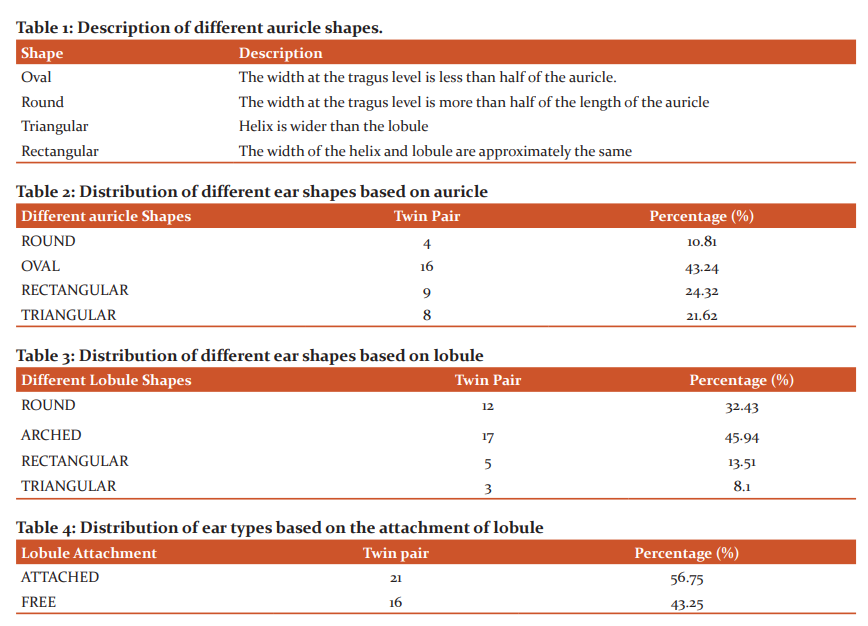

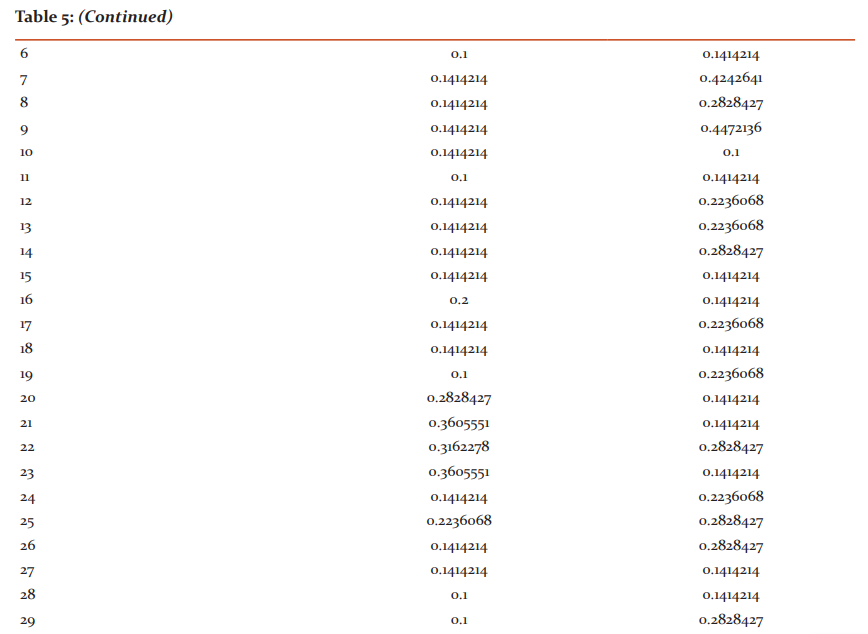
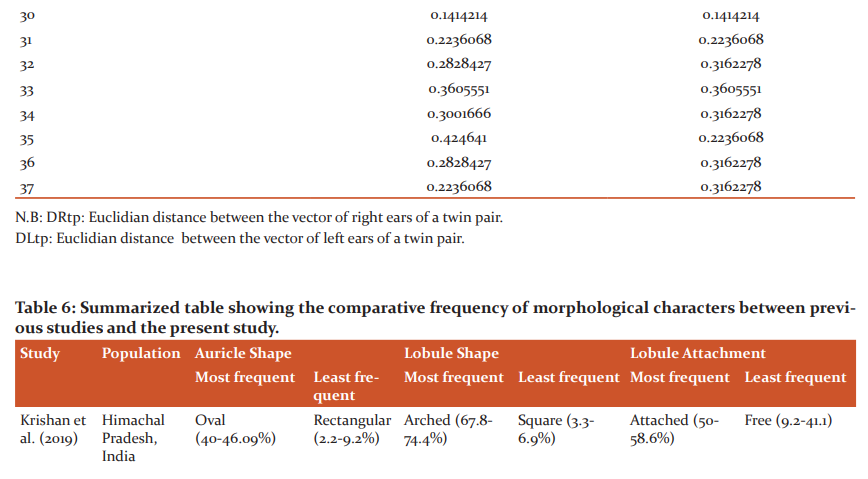


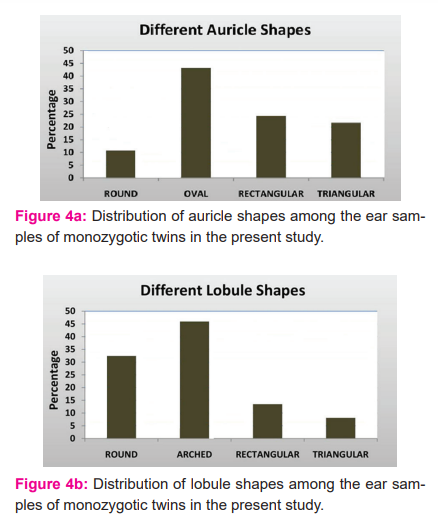
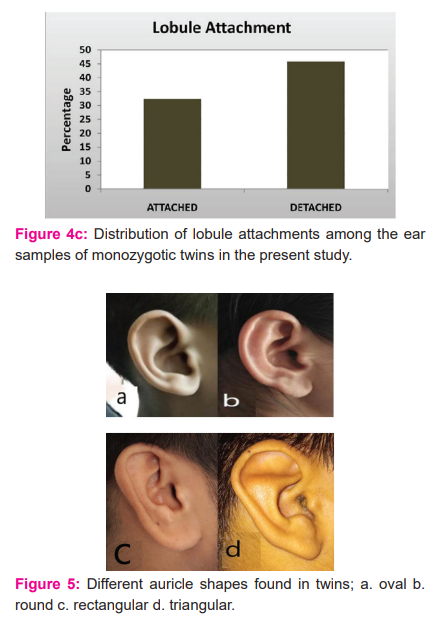

References:
1. Burbridge D, Galton F. Twins heredity and social class. Bri J Heal Sci. 2001; 34: 323-40.
2. Hall JG, Twinning. The Lancet. 2003; 362: 735-743.
3. Jodalli P, Panchmal GS, Sonde L and Somaraj V. Village of Twins: A Mystery. JOADMS 2016; 2: 3-6.
4. Mayo O. Early Research on Human Genetics Using the Twin Method: Who Invented the Method? Twin Res Hum Genet. 2009; 12: 237-45.
5. Wang LF, Yang Y, Zhang XN, Quan XL and Wu YM. The tri-allelic pattern of short tandem repeats identifies the murderer among monozygotic twins and suggests an embryonic mutational origin. Forensic Sci. Int. Genet. 2015; 16: 239-45.
6. Weber-Lehman J, Schilling E, Gradl G, Richter DC, Wiehler J and Rolf B . Finding the needle in the haystack: Differentiating “identical” twins in paternity testing and forensics by ultra-deep next-generation sequencing. Forensic Sci. Int. Genet. 2014; 9: 42-46.
7. Krawczak M, Budowle B, Weber Lehmann J and Rolf B. Distinguishing genetically between the germlines of male monozygotic twins. PLOS Genetics. 2018; 14: 1-9
8. Purkait R and Singh P. A test of the individuality of human external ear pattern: Its application in the field of personal identification. Forensic Sci. Int.2008; 178: 112-18.
9. Jain AK, Ross A and Prabhakar S. An introduction to biometric recognition. IEEETransCircuits Syst Video Technol. 2004; 14: 4-20.
10. Krishan K, Kanchan T and Thakur S. A study of morphological variations of the human ear for its applications in personal identification. Egypt. J Forensic Sci. 2019; 9: 1-11.
11. Krishan K, Kanchan T. Identification: Prints - Ear. J. Forensic Leg. Med.2016; 3: 74-80.
12. Kumar A, Wu C. Automated human identification using ear imaging.Pattern Recognit.2011; 45: 956-68.
13. Annapurna K, Sadiq MAK and Malathy C. Fusion of the shape of the ear and tragus - A unique feature extraction method for the ear authentication system. Expert Syst. Appl.2015; 42: 649-656.
14. Chattopadhyay PK and Bhatia S. Morphological examination of the ear: A study of an Indian population. Leg. Med. 2009; 11: 190-93.
15. Rubio O, Galera V and Alonso MC. Morphological variability of the earlobe in a Spanish population sample. Homo. 2017; 68: 222-235.
16. Purkait R. External ear: an analysis of its uniqueness. Egypt J Forensic Sci. 2016; 6: 99-107.
17. Verma P, Sandhu HK, Verma KG, Goyal S, Sudan M, and Ladgotra A. Morphological variations, and biometrics of ear: an aid to personal identification. J Con Drug Res. 2016; 10: 138-42.
18. Alexander KS, Stott DJ, Sivakumar B and Kang N. A morphometric study of the human ear. . Plast Reconstr Aesthe. Surg. 2011; 64: 41-47.
19. Kearney B. Variations of the external ear in an Australian population for identification. A thesis submitted to the University of Adelaide, in partial fulfilment for the award of Bachelor of Science (Honors)2003. http://www.eleceng.adelaide.edu.au/personal/dabbott/tamanshud/kearney_ oct2003.pdf.
20. Twins Lynn Meijerman, Andrew Thean, et al. Individualization of Earprints Variation in Prints of Monozygotic. Forensic Sci Med Pathol. 2006; 2: 39-49.
21. Cameriere R, DeAngelis D and Ferrante L. Ear identification: a pilot study. J. Forensic Sci. 2011; 56: 1010-1014.
22. Guyomarc'h P and Stephan CN. The validity of ear prediction guidelines used in facial approximation. J Forensic Sci. 2012; 57: 1427-1441.
23. Swift B, Rutty GN. The human ear: its role in forensic practice. J. Forensic Sci.2003; 48: 153-160.
24. Singh P, Purkait R. Observations of external ear-an Indian study. Homo 2009; 60: 461-72.
25. Iannarelli AV. Ear identification, Forensic identification series. Paramount Publishing Company, Fremont; 1989.
26. Van der Lugt C. Ear Identification. Elsevier, Bedrijifsinformatie’s Gravenhage, Amsterdam; 2001.
27. Yadav MM, Nigam K, Srivastava A and Yadav VK. A Preliminary Study on Frequency Distribution & Inheritance Pattern of Different Characteristics of Ear among Population of Moth Region of Jhansi District. Int J Res Ass Engg Tech. 2017; 5: 236-41.
28. Farkas LG. Anthropometry of normal and anomalous ears. Clin Plast Surg. 1978; 5: 401-412.
29. Gable NE. A racial study of the Fijians. In: Anthropological records. University of California Press, Berkeley and Los Angeles; 1958.
30. Bhowmik DC. Ear lobe attachment in Uttar Pradesh. Man India 1971; 51: 157-161.
31. Taura MG, Adamu LH and Modibbo MH. External ear anthropometry among Hausas of Nigeria: the search of sexual dimorphism and correlations. World J Med Sci.2013; 1: 91-95.
|






 This work is licensed under a Creative Commons Attribution-NonCommercial 4.0 International License
This work is licensed under a Creative Commons Attribution-NonCommercial 4.0 International License